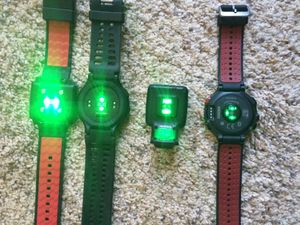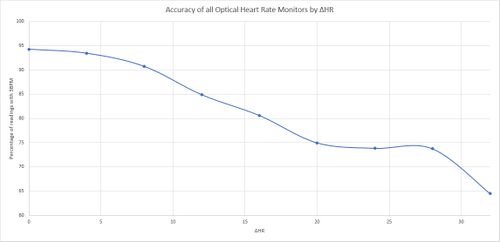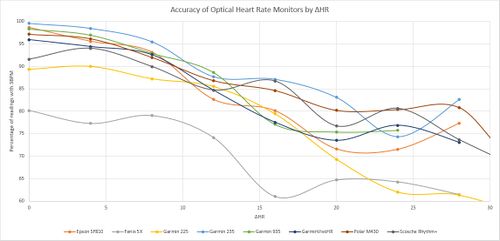Optical Heart Rate Monitoring
Optical Heart Rate Monitoring detects the changes in blood flow that occur with each heartbeat. Most optical heart rate monitors for use while exercising shine a green light into the skin and use a receptor to detect the changes in the reflected light. This approach has been used for decades, and I had an early version back in the 1980s. The latest optical heart rate monitors are vastly superior, but still have many accuracy issues. The most accurate form of heart rate monitoring is to use a chest strap that picks up the electrical signal from the heart. While a chest strap is not perfect, it works remarkably well as long as it has good contact with your skin, the battery is not flat, and the strap is not damaged. The accuracy of Optical Heart Rate Monitoring (OHRM) will depend on a number of factors:
- The watch needs to fit just right. Because of the sensor is measuring the changes in blood flow with each heartbeat, too much pressure will push the blood away from the sensor. However, to lose and the watch won't get a good reading due to lack of contact. Getting this tension just right can be tricky, especially if you're wrist expands or contracts over time.
- Temperature seems to be a huge factor, and most systems work better in warmer conditions. If you're a little chilled, your body will restrict superficial blood flow to retain body heat, making it much harder for the optical HRM. In my experience, the issue is mostly around how warm you are when running, rather than at the absolute temperature. I've found that optical heart rate monitors can do better in colder conditions when I'm wrapped up warm and sweating a slightly than they will do in mild conditions where I'm running with the bear arms.
- Naturally, because optical heart rate monitoring systems need to be against the skin, it can be tricky to use them in cold conditions. I've cut a hole in an arm warmer so that I can see the watch face while preventing frostbite to the surrounding skin.
- Movement seems to confuse OHRM systems, possibly because it changes the papillary filling. Some users have noted that their OHRM systems seem to lock on to their Cadence rather than their heart rate. The OHRM systems use a (accelerometer) to try to filter out movement related artifacts.
- Changes in your heart rate tend to cause problems for OHRM systems. My testing indicates that running at a steady, even intensity makes things a lot easier for the sensor. Changes in intensity, such as interval training, tend to cause problems. Sometimes these problems are the OHRM system doesn't seem to notice the change in heart rate continues on as if nothing had happened, and sometimes the OHRM system becomes disassociated with the real heart rate, either going up or down too far, or sometimes moving in the opposite direction.
- It's possible that bright sunlight might also influence the accuracy, though I've not noticed any obvious correlation. I typically run in shady conditions, so this may not be an issue I've been exposed to.
- Skin pigmentation and tattoos can interfere with the light. My skin tone is quite pale, so uses with greater pigmentation may have far more problems, and putting the OHRM sensor over a tattoo is unlikely to work.
Contents
1 How to Best Use an Optical Heart Rate Monitor
If you have reasonably pale skin, and you can find an optical heart rate monitor that fits your wrist effectively, and you're prepared to accept a little inaccuracy, then an optical heart rate monitor might be viable for you under specific conditions. My suggestion is to use the optical heart rate monitor when it's likely to work, and use a chest strap heart rate monitor at other times. This means avoiding the optical system if you're doing any form of interval training, and only use it when you're running at a steady, even pace.

2 Testing Optical Heart Rate Monitors
To evaluate the accuracy in a more quantifiable manner I've analyzed the heart rate of readings of several optical heart rate monitors compared with a chest strap based monitor. I've spent months gathering over 1 million data points, and developing analysis software defined patterns in the data. I found two factors that influence the accuracy; temperature and rate of change of heart rate (delta HR, or ΔHR). I'm defining ΔHR as the difference between the highest and lowest heart rate values recorded using the chest strap in the preceding 60 seconds, so a ΔHR of 5 could come from a heart rate range of 130 to 135.
- About 78% of readings across all of the optical heart rate monitors is within 3 BPM of the correct reading. That's pretty grim in my opinion.
- When the temperature is warm (between 68f/20c and 85f/20c) about 83% of readings across all of the optical heart rate monitors is within 3 BPM of the correct reading.
- When the ΔHR is 5 BPM or less, about 85% of readings across all of the optical heart rate monitors is within three BPM of the correct reading.
- When the temperature is warm (between 68f/20c and 85f/20c) and ΔHR is 5 BPM or less, about 90% of readings across all of the optical heart rate monitors is within three BPM of the correct reading.
2.1 Optical Heart Rate Monitors In The Warm
Because optical heart rate monitoring relies on blood flow to the skin, air temperature is an important factor in accuracy. In practice, the relationship is a little more complex than you might expect. Warmer temperatures will add heat stress to a runner, and blood will flow to the skin to help control temperature. However, the relationship between air temperature and heat stress on the runner will depend on exercise intensity, as high intensity will produce more heat to be dispersed. Heat stress will also depend on humidity, as the evaporative cooling of sweat is less effective. Another factor is BMI, as higher BMI values represent less effective surface area to volume ratio. Finally, the amount of clothing you wear will have an effect on both heat stress and localized blood flow. You'll notice that the accuracy at 40f/4c is fractionally better than at 50f/10c, and this is because I wear an arm warmer with a hole cut in it at lower temperatures. (I have experimented with wearing an arm warmer in moderate conditions, but the discomfort makes this a little impractical for me.) All this means that the temperatures shown below should not be taken as absolute, but as a general indication that temperature is an important factor, and optical heart rate monitors are probably impractical in cooler conditions for most runners.
2.2 Accuracy and Rate Of Change Of Heart Rate
Another patent in my data is that optical heart rate monitors tended to do quite well if my heart rate is steady, but don't track changes in heart rate very well, and can often become completely lost. This means that I can slow up and the optical heart rate monitor reading can jump wildly high, or I can start a high intensity interval and the reading can drop. I'm using ΔHR to mean the difference between the highest and lowest heart rate values recorded using the chest strap in the preceding 60 seconds. Naturally, ΔHR and air temperature interact, so let's look at how optical heart rate monitors cope with changes in heart rate under ideal (68f/20c to 85f/20c) conditions. You'll notice a fairly rapid decline in accuracy as heart rate becomes a changeable.
The graph below breaks down the accuracy by specific device. Some devices clearly do better than others, but I'd urge caution in interpreting this data, as different devices might fit different people better or worse. Looking at the Garmin Fenix 5X, which does far worse than any other device, but I strongly suspect that the due to the weight of the device. This means the Fenix 5X is moving around rather more than a lighter device, increasing the number of bad readings. Even the best devices here only work reasonably well when my heart rate is fairly steady. Even moderate changes in heart rate cause a fairly significant drop in accuracy.
2.3 Verifying Chest Strap Gold Standard
My first step was to verify that the chest strap based monitor is reasonably accurate. To do this, I ran with two different chest strap systems, a Garmin Ant+ (HRM4) and a Polar Bluetooth (H7). I compared over 10,000 readings and found that the two systems matched extremely well. I have uploaded the results below, using two different visualizations. The first graph shows the heart rate measured by the Garmin HRM4 on the horizontal against the Polar H7 on the vertical. If the two systems match exactly then the point will be on the green line of equality. You can see a few places where the two systems don't line up perfectly, but the vast majority of the readings align within a couple of heartbeats. I've used transparent points to give a better impression of the density of data, with black areas having at least 10 data points lining up. There is a blue regression line, which will be aligned with the green line if the system is accurate. I've also included two red lines that are 25 bpm away from the true value. The second graph shows the distribution of differences between the two systems, and again we can see that the vast majority of data points are within a couple of beats. For those with a statistical background, the standard deviation is 1.55 BPM with a bias of -0.06 BPM. <gallery widths=300px heights=300px class="center"> File:VerifyScatter.png| The distribution of readings between the Polar Bluetooth system vertically and the Garman Ant+ system horizontally. This is how the distribution should look if the system being tested is accurate. File:VerifyDistribution.png| Here is another view of the same data, showing the most readings were exactly the same, or differing by just a couple of beats. </gallary>
3 Optical Heart Rate Monitors Compared With Pulse Oximeters
Main article: Pulse Oximeters Pulse oximeters are the small devices that are clipped to your fingertip to measure your pulse and oxygen saturation. Like optical heart rate monitors, pulse oximeters measure your pulse using a similar approach of looking for changes in how light is absorbed. While pulse oximeters provide a reliable and sufficiently accurate measure of your heart rate, they are extremely sensitive to movement, and your finger needs to be completely still.
4 How Optical Heart Rate Monitors Work
Optical Heart Rate Monitors for use when exercising have two sensors, one for detecting light, and the other for detecting movement. They shine a light into the skin, and then measure how much is reflected back to the light detector. Some of this variation is due to the beating of the heart, but some is due to a motion, especially motion related to each step. The optical heart rate monitors use the accelerometer to detect movement and will attempt to account for this. The difficulty of extracting the wanted signal from the noise is a primary reason why optical heart rate monitors have so many accuracy problems. The issue of step based noise is particularly problematic as the frequencies tend to be similar. It's been noted that optical heart rate monitoring may be less accurate when cycling than when running. One possible explanation that occurs to me is that the noise may be related to muscular contractions, rather than the impact of landing.


